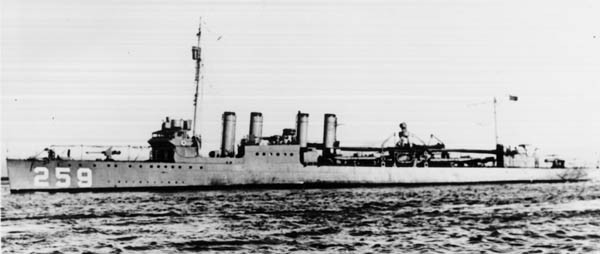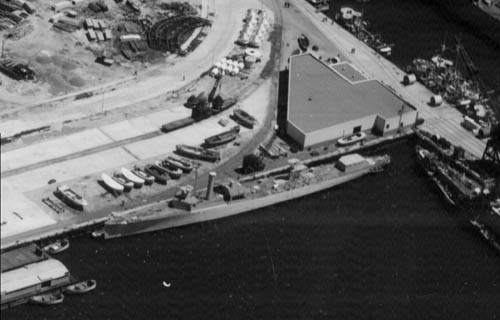Turner I (Destroyer No. 259)
1919-1936

Daniel Turner, probably born at Richmond on Staten Island in 1794, was appointed a midshipman in the Navy on 1 January 1808. Following brief duty at the New York Naval Station, he served in the frigate Constitution on the North Atlantic Station. On 8 June 1812, he received orders to Norwich, Conn., where he took command of the gunboats located there.
On 14 March 1813, two days after receiving his commission as a lieutenant, Turner was sent to Sackets Harbor, N.Y., located on the shores of Lake Ontario. There, he took command of Niagara, a brig in Oliver Hazard Perry's squadron. However, just before the Battle of Lake Erie, he relinquished command to Capt. Jesse D. Elliott and assumed command of Caledonia.
That little brig played an important role in the Battle of Lake Erie on 10 September 1813 because, at one point in the action, her two 24-pounder long guns were the only ones in Perry's flotilla capable of returning the distant fire of the three heaviest British ships then in the process of pounding Perry's flagship Lawrence. For his part in the U.S. victory at Lake Erie, Lt. Turner received Perry's praise, a vote of thanks and a medal from Congress, and a sword from the state of New York.
In the summer of 1814, Turner succeeded to the command of schooner Scorpion, and he cruised Lakes Erie and Huron, supporting army operations around Detroit and blockading British forces at the Nottawasaga River and Lake Simcoe. On 6 September 1814, Turner and his command were captured by the British when he brought Scorpion alongside the former U.S. schooner Tigress which, unbeknownst to him, had been captured a few days earlier. After a period of imprisonment at Mackinac, Lt. Turner returned to the United States in exchange for a British prisoner of war.
Between 1815 and 1817, Turner cruised the Mediterranean in the frigate Java commanded by Oliver Hazard Perry, his old superior on the Great Lakes. During that deployment, Java visited Algiers and Tripoli in a show of American naval strength calculated to impress the Barbary pirates and intimidate them into honoring their treaties with the United States. In 1817, Java returned to Newport, R.I., to be laid up.
Between 1819 and 1824, Turner returned to sea in the schooner Nonsuch attached to a squadron commanded again by Oliver Hazard Perry. In addition to hunting West Indian pirates, his ship sailed up the Orinoco River to carry Perry on a diplomatic mission to the Venezuelan government under Simon Bolivar. During the return downriver, however, Perry and many of the crew contracted yellow fever. Turner was close at hand when his mentor died at Trinidad on 23 August 1819. During the remaining years of Turner's assignment to Nonsuch, his ship worked along the east coast of the U.S., patrolled in the West Indies to suppress piracy, and made a brief cruise to the Mediterranean in 1824.
Following shore duty at Boston, Turner returned to sea in 1827 for a three-year assignment with the West India Squadron, as the commanding officer of Erie. In 1830, he came ashore again for three years at the Portsmouth (N.H.) Navy Yard.
Promoted to captain on 3 March 1835, Turner spent a long period awaiting orders before returning to sea in 1839 in command of Constitution. He sailed the Pacific Station in "Old Ironsides," until he was relieved in 1841. From 1843 to 1846, he commanded the U.S. squadron that operated along the Brazilian coast. From that duty, he reported ashore again as Commandant, Portsmouth Navy Yard. Capt. Turner died suddenly on 4 February 1850 at Philadelphia, and he was buried in Greenmount Cemetery in Baltimore, Maryland.
I
(Destroyer No. 259: displacement 1,308 (full load); length 314'4½"; beam 30'11½"; draft 9'4" (mean); speed 34.16 knots (trial); armament 4 4-inch, 1 3-inch, 12 21-inch torpedo tubes; complement 122; class Clemson)
The unnamed Destroyer No. 259 was laid down on 19 December 1918 at Quincy, Mass., by Bethlehem Shipbuilding Corp.; named Turner on 15 May 1919; launched on 17 May 1919; sponsored by Mrs. Leigh C. Palmer, wife of the then-current Chief of the Bureau of Navigation; delivered to the Navy at the Boston Navy Yard on 23 September 1919, and commissioned there on 24 September 1919, Lt. Cmdr. Mark L. Hersey, Jr., in command.
After duty along the east and west coasts, Turner, given the alphanumeric identification number DD-259 on 17 July 1920, was later placed in rotating reserve as part of Destroyer Division 29, Squadron 4, Flotilla 2, Destroyer Force, U.S. Pacific Fleet. Ultimately decommissioned at San Diego, Calif., on 7 June 1922, Turner was placed in reserve. Her name was stricken from the Navy Register on 5 August 1936.
On 28 September 1936, however, the ship was authorized for conversion to a non-self-propelled water barge (YW), with a capacity of 80,000 gallons. Her conversion completed at San Diego on 23 October 1936, she was reclassified as the unnamed district craft YW-56 and began operations in the San Diego area. She was assigned to the Eleventh Naval District on 17 October 1940, and in May 1942, her mobility restored, was given additional duty as a ferry between San Diego and San Clemente Island.
YW-56 was named Moosehead (q.v.) and redesignated as a miscellaneous vessel, IX-98, on 13 February 1943.

Updated, Robert J. Cressman
11 January 2024


